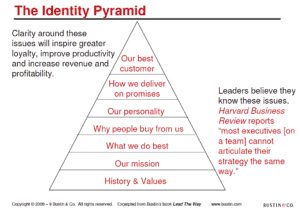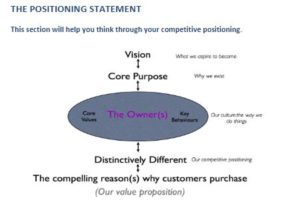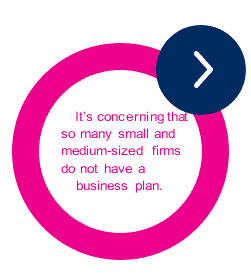Our Ultimate Guide to Strategic Planning
Part A: Business Strategy Check List
1. Analysis of Existing Situation – Organisational Philosophy & Mission & Value
- Does it reflect what you stand for?
- Do your people understand its true meaning?
- Does it make it clear as to how you have to compete and against whom?
- Is it simply written? Is it clear and unambiguous? Is it believable and realistic?
- Does it motivate people? Does it attract pride or cynicism?
- Does it give us some indication of what we should be doing and how we should be doing it?
- Do all the constituent parts fit and hang together?
- “Identity Pyramid” – do you have clarity around all the issues?

2. Internal Appraisal of Company
- SWOT analysis – revisit previous analysis & ensure it is complete & current
- Distinguish between endowments and core competencies
- Assess and audit core capabilities.
- Gauge fit between external environment and core capabilities
- Identify fit between customer requirements and core capabilities
Having identified what you perceive to be your competences ask yourself the following questions:
- Will this give us any source of long term sustainable competitive advantage? Clarify the how? (ie. how relevant is it to the needs of our customers (actual and potential)).
- Do customers (broadly) agree with our findings (ie. the market place)?
- Can competitors (present/future) emulate or do better? Do they share our perception?
- How was this list of core competences arrived at (eg. Training, innovation etc)?
- Any weaknesses/shortfall still? If so, what further investments will be required?
- Is there any impact on the strategic balance sheet (ie. Intangible and human assets)?
- Can it be levered, onto other applications and/or markets?
- What happens next?
3. Competitive Analysis
- What is the current process for this task?
- The Positioning Statement (competitive positioning) – refer below
- Scan present competitive position but focus also on future competition.
- Do you really know your competitors strategy?
- Understand changing face of competition
- Who could be a future competitor?
- Is your strategy and your competitors becoming more alike or more divergent?
- What is the most radical thing that your competitor(s) could do?

4.Value Proposition
- Consider or revisit the current Unique Sales Proposition within your Marketing plan & ensure it is complete and up-to-date.
- Do you know why your customers buy from you and not you competitor(s)?
- Have you asked them?
- How can you improve customer experience?
5. Environmental & Industry Analysis
- Consider legal, social, political, economic, technological, markets, labour position, society, pressure groups, and any other environmental issue.
- Assess potential impact of any change(s) and consider timing implications.
- Conduct intensive industry analysis.
- What is the long-term viability of the industry as a whole?
- What could change the industry dynamics?
- What is the nature of current industry changes i.e. radical, creative, intermediate or progressive?
- What could be the impact on your strategy and source of competitive advantage of such changes?
- Five years or so from now how will the industry leaders look and act?
Part B: Strategy Selection
1. Identify Strategic Alternatives
- All options to be examined – growth, acquisitions, alliances, JV’s, innovation.
- Upside and downside risks identified
2. Strategy Evaluation & Selection
- Clear choice to be made
- How will we compete?
- Evaluate impact of each option
- Will it give unique competitive advantage?
- Can it last? Can it be sustained?
- Will it differentiate us from our competitors?
- Can it be converted easily into a set of business objectives / KPI’s?
- How will competitors react?
- Easy to implement?
- Contingencies in place?
- What about the next wave?
- Is it consistent with customer requirements and industry changes?
- Will it create shareholder value?
- Is it financially viable?
Part C: Strategy Implementation
1. Matching Strategy & Organisational Structure
- Do we have the necessary resources?
- Is there a logical fit?
- Is current structure adequate? Assess extent of change. Do not ignore culture effect.
- What about the organisation’s values?
- Is strategy personalised enough? Assess flexibility and robustness.
2. Allocation of Resources & Responsibilities
- Planning, Plans, budgets, controls, appraisals etc….. all to be consistent with strategy
- Strategy well translated into clear objectives
- Priorities and constraints identified
- Time horizons clearly laid out
- Management information systems to dovetail strategic choice
Without a comprehensive, up-to-date business plan and an implementation timetable, companies may be missing out on opportunities for growth and not realising their full potential. A formal plan can be an extremely valuable tool for managing and growing a business, as it allows a company to recognise its strengths and weaknesses. Furthermore, research has shown that SMEs that have a business plan in place are consistently more profitable than those who do not have a business plan.




